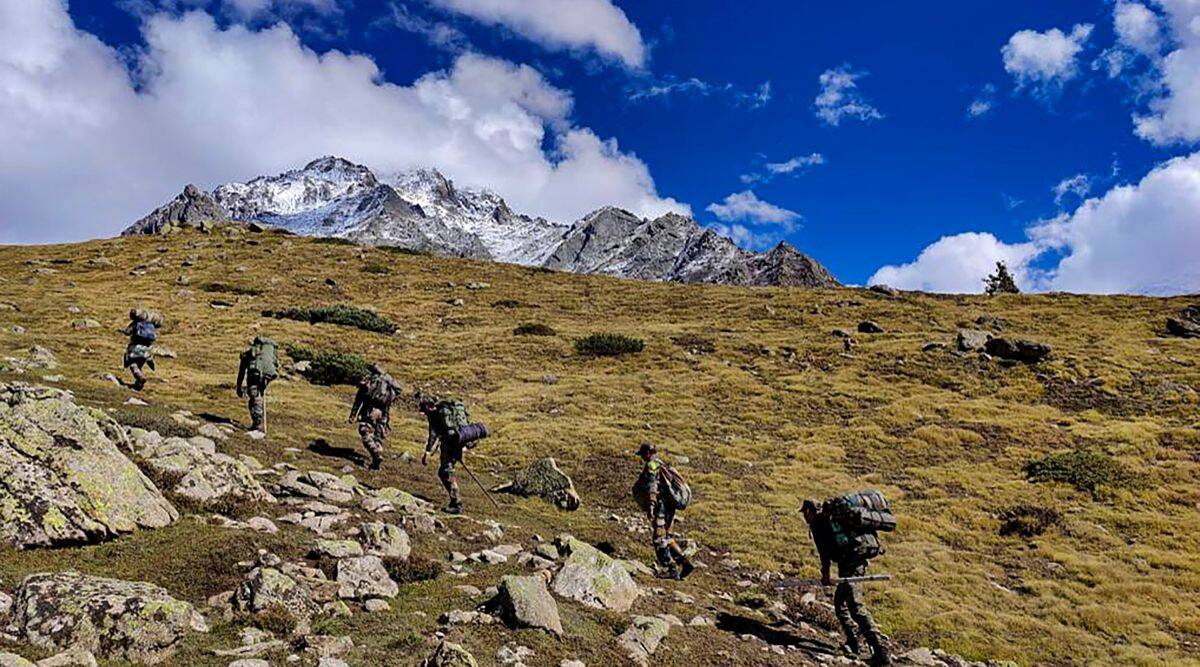 Army personnel move towards the avalanche site to carry out rescue operations in Uttarkashi district. (Twitter/@ADGPI)
Army personnel move towards the avalanche site to carry out rescue operations in Uttarkashi district. (Twitter/@ADGPI)On October 4, Pune-based IT professional Sayali Budhkar was all set to scale the Draupadi-ka-Danda-II peak in Uttarkashi district. But as she complained of a headache, her instructors advised Budhkar against proceeding towards the summit.
Along with 13 others who reported fluctuation in blood pressure and oxygen levels, Budkar stayed back at a camp located at a lower altitude, having to give up on her plans to complete the height-gain test – a key part of the advanced mountaineering course.
The move, though, proved to be a life-saver for the 26-year-old who later learnt that the 41-member team of mountaineers from the Nehru Institute of Mountaineering (NIM) she was supposed to climb the summit with had been hit by a slab avalanche. As on Friday, at least 26 people were killed and a few more reported missing in the incident.
Speaking with The Indian Express over phone from NIM, Uttarkashi, on Friday, Budhkar, a trainee mountaineer, says, “While two of the leading instructors had already reached the summit and two other team members were at the tail end, the avalanche hit all the mountaineers stationed in between.”
 Sayali Budhkar stayed back at a camp in lower altitude, while majority of her training batchmates proceeded towards the summit. (Express Photo)
Sayali Budhkar stayed back at a camp in lower altitude, while majority of her training batchmates proceeded towards the summit. (Express Photo) Such was the impact of the slab avalanche that it hit mountaineers who were positioned along a line, pushing them into a nearby crevice, says Budhkar who is yet to come to terms with the loss of her fellow mountaineers with whom she had laughed and clicked pictures until early this week.
The tragedy has left many Pune-based mountaineering experts shocked who say the Draupadi-ka-Danda-II peak in Uttarakhand, with no history of avalanches in the past three decades, is considered among the safest for conducting mountaineering training.
Says Bhushan Harshse, Institute Operations Head at Pune-based Guardian Giripremi Institute of Mountaineering (GGIM): “The site is considered a safe one for many reasons — it has a wide valley with close access from the road. Due to slow or gradual altitude gain, most mountaineers manage to reach higher altitudes or even the summit. In this process, they get acclimatised to the altitude and weather. But this is not the case when there is sharp altitude gain resulting in more mountaineers falling by.” Harshe last visited the site in Gangotri in 2021 as an instructor to a batch of students from Savitribai Phule Pune University pursuing a diploma in mountaineering.
September-October and April to June periods are best for 28-day-long basic or advanced mountaineering training sessions in the Gangotri range led by India’s five leading mountaineering institutes, according to experts.
“I had undergone training at this site in the early 1980s. It has been a safe site where all mountaineering institutes conduct training,” says Umesh Zirpe, president, Akhil Maharashtra Giryarohan Mahasangh, and a mountaineer for 40 years.
Harshe notes that the site — located 5,670 metres above sea level in Garhwal Himalayas — is also under regular glacial health monitoring performed by scientists from the Dehradun-based Wadia Institute of Himalayan Geology. “There are always updates available about this site. It supports vegetation and the local streams make water available. NIM would be knowing every minute detail and corner of this site,” he says.
 Sayali Budhkar at NIM, Uttarkashi. (Express Photo)
Sayali Budhkar at NIM, Uttarkashi. (Express Photo) NIM had, in the past, explored four to five other sites — including those near Kedarnath and other locations in Gangotri – but ruled them out for training purposes due to potential risks of shooting rocks, narrow valleys restricting chopper ferries in case of emergency, hard slopes and difficult trails and hostile terrain to allow passage of mules or porters to carry support materials for the mountaineers.
Experts are of the opinion that while global warming might be accelerating the rate of snow melting in higher altitudes, the fragile and loose Himalayan ranges were getting severely impacted due to unprecedented slicing of mountains. “Be it for building roads, hotels or construction of houses in the hills of Uttarakhand, the damage will have a huge price to pay in future,” says Zirpe.
He further adds, “The human population on these hills is increasing. The mountains are being rampantly cut to build roads and other development works… all of these are posing harm to the environment and it is like inviting nature’s wrath.”
The arrival of desired rescue, Zirpe says, is key to saving lives of those involved in such accidents.
“There are too many restrictions in India and rescue should ideally reach within the first 15 to 30 minutes. In this aspect, Nepal is far ahead and the administration there is equipped with quick and long-range rescue teams and light helicopters to ferry in such treacherous terrains,” says the veteran mountaineer.
The incident may have left Budhkar hurt and shaken but she has no doubts that she would return to the mountains soon.
“It is a part of growing stronger and I see it as a process of learning. I may be lucky because, due to a headache, I was advised not to proceed towards the summit. But I will return to the mountains as it is my passion. I believe there are bigger heights to scale. It’s the sole reason I survived,” she says.